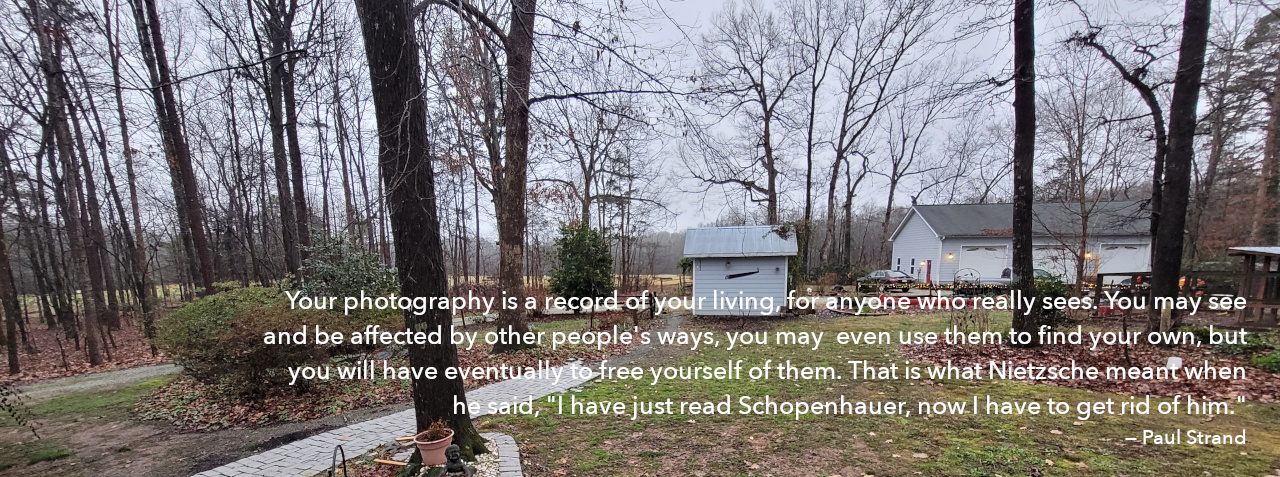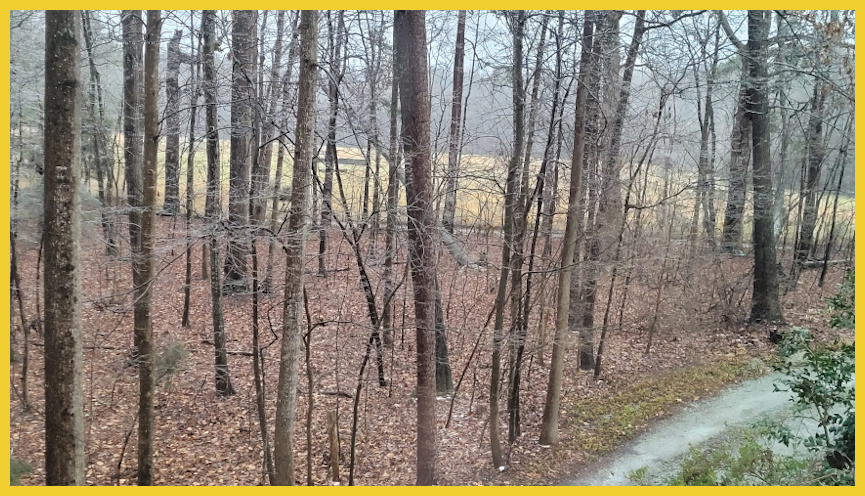Icy wintry mix on the trees.
The final day, and I think I’ll indulge myself in a little writing in the journal. A fling and a lark.
Temperature is hovering around freezing, and it’s raining a mix of sleet and just plain old raindrops. No snowflakes, which are probably saturated by neighbors on the way down to earth. The deck was slushy as Rosie and I went out for our walk. She didn’t seem to mind the mild wetness, and so we had a good walk. I didn’t expect power interruptions when I heard the forecast, so we didn’t fill up a bucket for water. No power outages, so we’re good.
Arlene will be happy that this is the last day of the picture-taking. It has been a bit consuming and an interruption. It’s also been something I’ve been cautious about. Bernadette Mayer mentioned the incompleteness of her collection of photos and the words, and I suspect that she consciously steered clear of certain things. She mentioned its absence in Memory in her preface to the book. “It’s astonishing to me that there is so much in Memory,” she wrote in a preface to the Siglio Press edition, “yet so much is left out: emotions, thoughts, sex, the relationship between poetry and light, storytelling, walking, and voyaging to name a few.” I recall that when I told a friend and colleague about the project I was planning, he said that he’d keep an eye out for it, but “please, no nudity.” Sounds like we’re British around here, I thought.
Memory, I noticed, has pictures of a MG Midget, a blue one that’s rather ratty, probably dating from the late 1960s, before British Leyland mucked up the design with God-awful rubber bumpers to appease US regulators. I owned a Midget, too, in the 1970s. Fun little car, frequently requiring some work, and fitted with the quirkiest old fashioned rear shock absorbers that I had to fiddle with at one (memorable) point.
When I drove up in it, my dad asked me when I’d get one for the other foot, it was so small.
One thing I tried to avoid were pictures of my family and Arlene, who appears in only one shot with Rosie. No pictures of the grandchild, few faces of our children (I think). It’ll be good to finish up the photos and get all settled on the web for a while. I’ve neglected putting up the journal entries for some time now. Only the pictures have made it, and I’m a week behind on those.
The arc of the project was turned – perhaps in no small measure – by the workings of the project itself. That’s a lens that I’ll have to take a close look at when I return to the “data” I’ve collected over the past month. And it is going to be a pile of data: I think the journal entries will be around 20,000 words, and the pictures … between six and seven hundred shots that I selected. (I gather that Bernadette used whatever she took.)
I have to chart the numbers on the “Bernadette-O-Meter” I’m thinking about.
I check my morning email newsletters every day as Arlene and I drink our coffee together in the bedroom. Today’s weekend edition of the New York Times daily update ended with the observation that there are 48 days until the first day of Spring. That’s welcome news, and it makes me think that others feel this yearning for Spring grow at the end of January and become more pressing as we move into February. The formerly welcome crispness of November and December yields to it just feeling cold outside. I know that I am not crazy about running around outside as much now, and the garage is just a gigantic refrigerator it seems. The dullness of today, with its rain and cold, just increases the yearning for warmth a bit more. I think in the absence of an appealing outdoors, I realize how much time we spend outside doing things. In the Spring, Summer, and Fall, we often spend evenings outside, too. Not this Winter, though.
It’s going to be a wet few days, as if we needed the rain. The soil is so saturated that nothing soaks in, and we have muddy rivers and standing water all over the place. The back yard is a swamp. Oh, well.
I sound like a grumpy old man. Actually, I’m just a cold, wet one, soaked to the bones.
It was a good day to do some baking, which is needed in any case. This time, I’m going to bake some cheese bread. And, in order to use a couple of packages of Italian sausage that I discovered had cracked bags, I’m going to make some meatloaf—a nice warming treat, and I do a pretty good job on it. The thing I like about meatloaf is that it’s easy, and it’s forgiving. You basically can put anything in it that seems to make moderate sense. I’ve found that it’s tough to really do a bad job, though I have to be careful about too many carbs, especially in the topping. I am adept at using Splenda in a way that doesn’t taste weird, at least with meatloaf.
It’ll warm up the kitchen today, and be a nice reassuring winter treat for a couple of days. Meatloaf is one of those plebeian meals that simply pleases and doesn’t put on airs of being haute cuisine. The recipe is, well, whatever seems to be hanging around, and since I went to Costco yesterday, there are plenty of refrigerator loiterers. One thing I noticed I’m missing that would have been good: some fresh celery. I did something a little adventurous, though. We have had a couple of cans of black beans in the pantry for a while. Despite the fairly high carb count, I stuck a can of beans into the mix. They won’t be as carby as, say, the oatmeal that I use, I thought. Might be interesting, too. As for green things? I tried adding Brussels sprouts last time I did a meatloaf, and it worked nicely.
I like a recipe that mixes it up a little, and that is the definition of meatloaf à la DeLong.
Tonight, as I was closing in the chickens, I saw an opossum nosing around the enclosed area of the coop. It was an ugly thing, and it seemed a not really big one. Probably a young opossum. I scared him (or her) out of the enclosure and the opossum escaped into the chicken yard where it sniffed around for an escape under the fence. I was a little apprehensive, because the things can be rabid, but I proceeded to scare it away, and it waddled through a garden. I was happy to be rid of it. Opossums have ravaged our coop before, killing hens in ruthless and messy fashion.
All the work of getting ready for dinner was for naught, since Arlene has to head into the doctor tomorrow, and she didn’t want to chance things with her blood sugars. I was a little upset about the wasted effort, but at least we have bread and food tomorrow in abundance.
I looked at the Reynolds Price book that Harris and Sartor did with photography of of his house, or rather the accumulation of his life that was held in the house. It made me wonder what happened to the house where Reynolds lived so long. It should be a place of reading and visiting there, out in the woods of the county. I hope whoever is in it knows and cherishes the ghosts that still reside in the place.
I remember Reynolds as a distant presence. I was at a wedding where he attended. Actually it was at the home of Dale and Phyllis Randall, whose daughter Lettie married Jeff Anderson, a neighbor of Reynolds and a handy fellow who put Reynolds’ house in order so he was self-sufficient after his back surgery. Jeff also helped Reynolds out in that first year of recovery. It was at that wedding where Reynolds concluded that something was awry with his back. It turned out to be cancer that nearly killed him quickly were it not for some adept surgery and treatment and, as Alex Harris puts it, the hand of Jesus, who was the subject of many, many drawings Reynolds drew as he was recovering and unable to write. The drawings fill six notebooks, as I recall.
I was always at the fringes, like most of the world of Duke, watching Reynolds occasionally surface and dwelling at the place he dwelt. But the place was shaped by the man in many ways that I think are still obscure, and I wonder what he’d think of it, now a decade after his death. There is a hole, it seems, that great men leave after they die. Even someone like me notices it—those who dwell at the edges of the lives of the great.
I looked at Memory again, with the question: how did Bernadette end the project? Here’s her last sentence, if indeed sentences are meaningful structures in her prose-poetry: “A process fills its old bed & then it makes a new bed: to you past structure is backwards, you forget, you remember the past backwards & forget.”
She used a period to end the text, I see.

